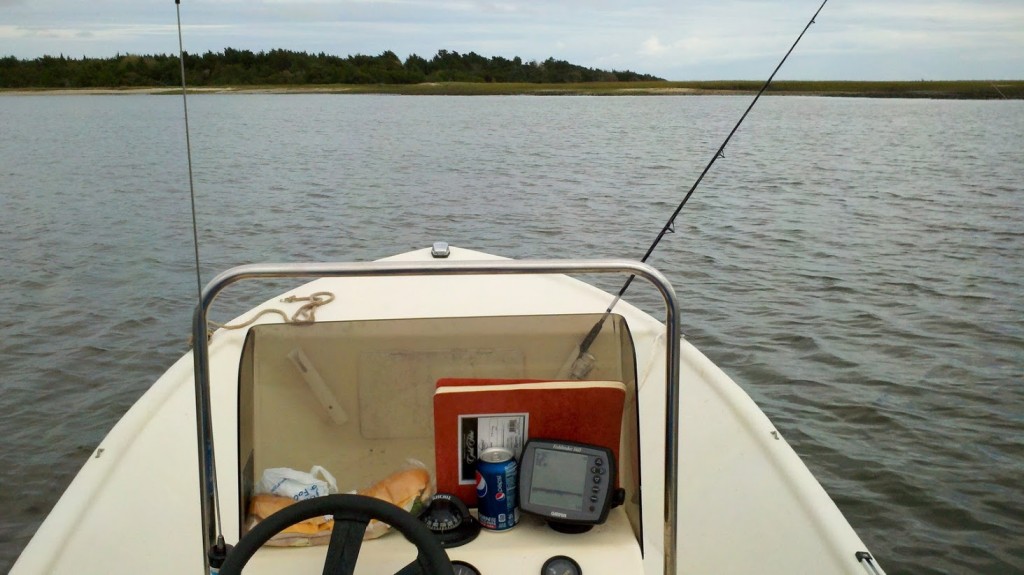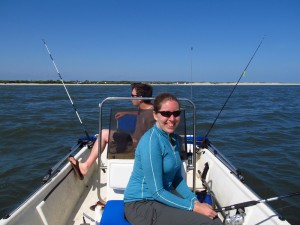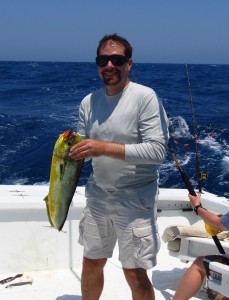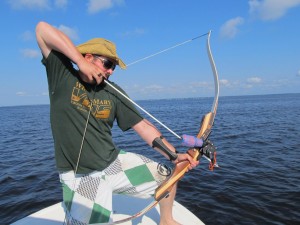In both my professional and private life, I am a man who wears many hats. I am a deep-sea ecologist, a science writer, a goatherd, a geneticist, a conservation advocate, a grill master, and many others. When David asked me to join him in co-authoring “Trophy fishing for species threatened with extinction: A way forward building on a history of conservation” I did so not in my capacity as a marine science Ph.D., but as a recreational fisherman who cares deeply about the survival of his sport. Without fish, there is no fishing.
I was, at first, skeptical, but over the course of a summer, I came to appreciate what David was trying to accomplish.

Before I talk about fish, I need to talk about birds.
I became an amateur birder during my honeymoon, while my wife and I backpacked across Iceland, the Faroes, and Denmark. I’ve never been particularly good with with birds and this trip provided me with an opportunity to sort out my gulls from my grebes. I picked up a few authoritative guides and pushed out into the northern wilds, searching for the elusive Harlequin duck.
It was around this time that David asked me to think about a small study on trophy fishing and its potential impact on threatened and endangered species recovery. Trophy fishing selectively targets the largest members of a population and, in many cases, the largest are also the most fecund. This means that, particularly for threatened species, a big female is worth much more than an average-sized female for the survival of the species. Trophy fishing targets these reproductive heavyweights.
And so my brain was filled with thoughts of birds and billfish as Amy and I made our way around the ring road from Reykjavik to Seyðisfjörður.
I don’t often have crystallizing moments in my research. For me, science is a slow climb towards understanding, a mountain built pebble by pebble. Such is population genetics, where the data wends it way downstream, a lazy river drifting inexorably towards the deep gulf of discovery.
I saw a Snowy Owl.
Not in the wild, of course, but in the pages of Johann Hilmarsson’s Icelandic Bird Guide. I’m fairly agnostic when it comes to owls–sea birds were my thing for this trip–but a footnote under the owl caught my eye. For every bird that nested or otherwise made its home in Iceland, there was a little map of the country with a note about the bird’s habitat and how to find it. The Snowy Owl’s map was blank; above it, the note read “Distribution not shown owing to species’ strictly protected status.”

It was my crystallizing moment. Over the next few days I chatted with birders and rangers to gain more clarity–no, Snowy Owls are not endangered, though their population is on the decline, they are rare within Iceland and, because they may be establishing breeding colonies, birders are encouraged to leave them alone. And no, this isn’t a fluke. Educated birders often steer clear of those species most vulnerable, especially their nesting grounds, so as not to put additional stress on the population.

The parallels were clear. Here were two recreational activities dependent on flourishing wildlife and driven, in part, by the rarity of the most desirable targets. In both cases, there’s a long history of conservation among stakeholders–birding organizations go to great lengths to protect vital habitat while fishermen, in my experience, are often the strongest advocates for healthy fish populations–no one wants to see their hobbies or livelihoods go extinct. In both cases, the activity in question was not the cause of the initial insult–birders certainly didn’t drive the California Condor to the brink, nor did trophy fishers launch the downwards spiral of many big fish.
This was a case of recreational stakeholder groups reflecting and self-regulating, essentially declaring “Hey, we know we’re not the reason snowy owls are declining, but since they are, maybe we should back off their crucial habitat and make it just a bit easier for them to bounce back.” I saw (and still see) that same potential within the trophy fishing community, the potential for self-reflection and self-regulation within a generally responsible community and from an organization with a long and notable track record of positive conservation work.
Going deeper.
I lied. I didn’t just join David’s team as a recreational fisherman, I joined in my role as a deep-sea ecologist as well, because the field of deep-sea research experienced a similar moment of self-reflection early in the 21st century. Emergent industries not-withstanding, at the moment, the worst thing that can happen to a hydrothermal vent is its discovery by science. Vent fields are fragile things, with rare and exquisite communities. The act of sampling them, hell, even the act of visiting them, can be destructive.
The deep-sea research community recognized this as a real problem and, in 2006, adopted a Code of Conduct for Responsible Research at Hydrothermal Vents. Here, again, is a professional organization recognizing the potential damage that could be caused by their activities, and choosing to self-regulate their behavior, not due to outside pressure–if I could convince the public to really fight for conservation in the deep sea at such a refined scale, the oceans would be in much better shape–but from internal acknowledgement of the potential damage of their current practices by current practitioners.

So I joined David, and several other exceptional scientists and ocean stakeholders, in co-authoring a short note in Marine Policy, encouraging the International Game Fish Association to cease record keeping for threatened and endangered species–essentially removing the incentive for anglers to bring these species to shore for an official weigh-in, a process that often results in the death of reproductively valuable individuals.
The response from the IGFA was… underwhelming.
Their rejoinder, issued by their conservation director, was churlish, mischaracterized our position, and was factually wrong about the IGFA’s own records*. As a recreational fisherman and a scientist eager for a spirited debate, I was disappointed.
Perhaps they raised their defenses too high; feeling attacked they went for the unilateral dismissal rather than taking the care and consideration that we invested in our position. I can understand that. The paper may have come as a broadside, catching them off guard. Regardless, the end result is that the IGFA is wrong to continue keeping records for threatened and endangered species, and wrong to defend their position while maintaining an otherwise strong record of conservation practices. I suspect that they know, having had now the time to consider our initial paper and discuss with a few of my co-authors, that they’ve fallen on the wrong side of this issue. I would not be surprised to see an organizational course correction in the near future.
Our response to their rejoinder was just published in Marine Policy. My only substantive supplement to our response is that I wish we had opened with this quote from former IGFA Vice President Philip Wylie:
The sportsman who brings intelligence as well as a mere instinct to his endeavors universally becomes the conservationist – and the conservation of fishes is of equal importance to the scientist, the angler, the commercial fisherman, and the general public. Fish, like the waters of the sea themselves, are the common property of all the people of the earth.
It is interesting to see some of the reactions to this discussion, many of which were unexpected. I’ve seen claims that we blamed trophy fishers for driving species to extinction, that we are calling for the heavy hand of the federal government to come crashing down on recreational fishermen, that we should have worked through private meetings rather than public criticism.
The first two are simply not true. We aren’t claiming that trophy fishing caused any species collapse but, now that the populations are in trouble, targeting the largest, most fecund individuals can have a significant impact on at-risk populations. And we’re calling on the organization that keeps trophy fishing records to update their record keeping practices; we’re calling for self-regulation. The IGFA has taken many steps to protect marine life and we presented yet another route towards our shared goal of healthy fish populations and healthy oceans for us all to enjoy.

To the final point, I simply say tough shit. The IGFA is a public-facing organization and should be able to defend its position in public. I’m not in the business of holding hands around a campfire while we sing about our feelings against the gentle backdrop of a poorly tuned guitar.
I’m a recreational fisherman. I co-authored this paper as a recreational fisherman because I want recreational fishermen to shape the future of sustainable, conservation-oriented, recreational fishing. If we don’t, someone else will. One day, far from now, I want to be able to land a Goliath Grouper with my granddaughter and tell her that, back in the day, we did everything we could to protect the fish and the sport that we love.
*In their response, the IGFA indicates that “in the last 20 years only 15 IGFA world records for the 85 IUCN Red List threatened species identified have been awarded”. In fact, according to the IGFA’s own records, 53 of the 85 species we identified as threatened or endangered had an IGFA all-tackle record awarded since 1994, including 6 critically endangered species: Catlocarpio siamensis, Chasmistes cujus, Pangasianodon gigas, Pangasius sanitwongsei, Hucho perryi, and Thunnus maccoyii; 18 endangered species: Balantiocheilos melanopterus, Pangasianodon hypophthalmus, Tor putitora, Aetobatus flagellum, Argyrosomus hololepidotus, Cheilinus undulatus, Dasyatis margarita, Epinephelus akaara, Hippoglossus hippoglossus, Mycteroperca fusca, Mycteroperca jordani, Pagrus pagrus, Raja undulata, Rhinobatos cemiculus, Rhynchobatus luebberti, Sebastolobus alascanus, Sphyrna lewini, and Sphyrna mokarran; and 29 vulnerable species: Cirrhinus cirrhosus, Hypsibarbus lagleri, Oreochromis andersonii, Balistes vetula, Carcharhinus longimanus, Carcharhinus plumbeus, Carcharhinus signatus, Cynoscion othonopterum, Centrophorus granulosus, Epinephelus bruneus, Epinephelus lanceolatus, Hyporthodus flavolimbatus, Hyporthodus niveatus, Isurus oxyrinchus, Lachnolaimus maximus, Lutjanus analis, Lutjanus cyanopterus, Megalops atlanticus, Melanogrammus aeglefinus, Mycteroperca interstitialis, Mycteroperca rosacea, Negaprion acutidens, Platyrhina sinensis, Plectropomus laevis, Rhynchobatus djiddensis, Semicossyphus pulcher, Sphyrna zygaena, Tautoga onitis, and Nemipterus virgatus.
That was a great read! Being in NJ and having a huge birding community(lots of snowies the last 2 yrs lol) along with fishing it really hit home. Our tournament promoters want nothing to do with tagging or conservation talks period nor does the APP( Apex Predator Program) want to come in and help in any way. Truly sad considering the APP originated here. I’ve observed at 3 tournaments this summer and while talking with the anglers(some I met up with afterwards also and we still communicate regularly) I found they were very open to tagging and release, some willing to pay out of their own pocket for the electronic tags to donate towards furthering research! IMO the anglers are getting it, its the tournament promoters that don’t want to lose the big money brought in. I think they have an unwarranted fear the tournaments will be less appealing in the end…Very sad state when a Mako Mania tournament only brings in 1 immature mako.
As both a marine biologist and an avid recreational fisherman, I understand what this note was attempting to accomplish. With all due respect, I have several issues with the paper. While it brings up a general biological principle amongst fish, that the largest individuals are female and fecundity increases with body size, this isn’t universally true. Ironically, you chose goliath grouper in the title of this post. This species, like many other groupers, is believed to be a protogynous hermaphrodite, and thus the largest individuals are male. However, one of my issues with the paper is the sole reliance on the IUCN as an indicator of the health of a species. Many of the reviews attempt a global status on a species, which may not be effective given that species may be represented by several discrete stocks.
A quick glance at some of the species on the red list reveals that many of the reviews are outdated and no longer reflect the current status of the species (or stock). For example, recent stock assessments have determined that shortfall mako sharks are not overfished in the northwest Atlantic and current harvest is sustainable. However, the IUCN has not updated the profile in 10 years and still lists the stock as vulnerable. Same for bigeye tuna in the Atlantic, which are not overfished. The Atlantic bluefin tuna stock has been increasing, and may not even be currently overfished depending on the recruitment scenario. Atlantic halibut have not been assessed in almost 20 years, and Canadian assessments have estimated the population to be above MSY.
In addition, many of the reviews rely solely on CPUE data, which may not provide an accurate picture of the stock’s status. For example, all three species of thresher sharks are listed as vulnerable based on longline CPUE data. However, the data used did not identify individuals to the species level and such species-specific conclusions are not possible. In addition, longline CPUE data would not be an effective means to assess the population of common thresher sharks in the northwest Atlantic because the species is neritic in nature and is found far inshore from where longliners typically operate. I would bet a majority of thresher species encountered are bigeye threshers.
The other major problem I had was the following contention: “If the IGFA stopped issuing records that implicitly require killing the fish for IUCN Red List Threatened species, it would immediately reduce fishing pressure on the largest individuals of species of conservation concern.”
This statement implies that anglers seeking All-Tackle records are causing pressure on the stocks, which is not backed up by any data. In fact, given that a vast majority of recreational anglers don’t target records, this is unlikely.
Melissa, Mako Mania had quite a few weigh-ins last year. The top six spots for the tournament were for makos between 200-300lbs.